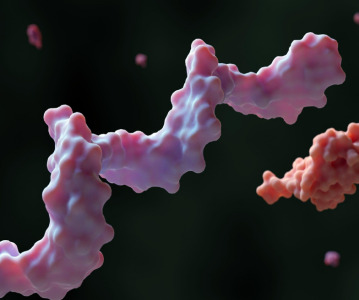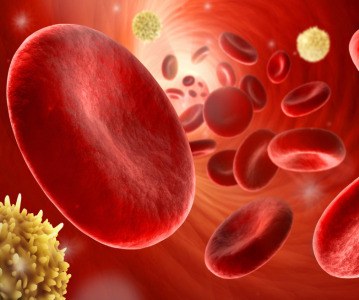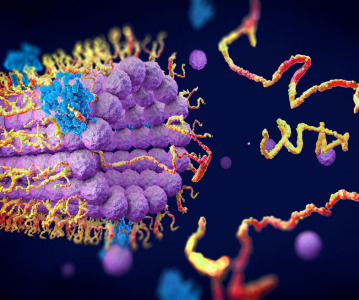Protein research offers ”promising” potential treatment of Alzheimer’s disease

Research co-led by the University of Glasgow has made a potential breakthrough in the treatment of Alzheimer’s disease.
The study, led by scientists at the University of Glasgow and the Hong Kong University of Science and Technology (HKUST), has discovered that a protein called IL-33 can reverse Alzheimer’s disease-like pathology and cognitive decline in mice.
The research, which is published in Proceedings of the National Academy of Sciences USA (PNAS), was co-led by Professor Eddy Liew from the University of Glasgow’s Institute of Infection, Immunity and Inflammation and Professor Nancy Ip of HKUST.
Professor Eddy Liew, Fellow of the Royal Society, who co-directed the research, said: “Alzheimer’s disease currently has an urgent unmet clinical need. We hope that our findings can eventually be translated into humans.
“IL-33 is a protein produced by various cell types in the body and is particularly abundant in the central nervous system (brain and spinal cord). We carried out experiments in a strain of mouse (APP/PS1) which develop progressive AD-like disease with ageing.
“We found that injection of IL-33 into aged APP/PS1 mice rapidly improved their memory and cognitive function to that of the age-matched normal mice within a week.”
The hallmarks of Alzheimer’s include the presence of extracellular amyloid plaque deposits and the formation of neurofibrillary tangles in the brain. During the course of the disease, ‘plaques’ and ‘tangles’ build up, leading to the loss of connections between nerve cells, and eventually to nerve cell death and loss of brain tissue.
IL-33 appears to work by mobilising microglia (immune cells in the brain) to surround the amyloid plagues, take them up and digest them and reduces the number and size of the plaques. IL-33 does so by inducing an enzyme called neprilysin, which is known to degrade soluble amyloid.
In addition, the IL-33 treatment worked by inhibiting the inflammation in the brain tissue, which has been shown earlier to potentiate plaque and tangle formation. Therefore IL-33 not only helps to clear the amyloid plague already formed but also prevent the deposition of the plaques and tangles in the first place.
Professor Liew added: “The relevance of this finding to human Alzheimer’s is at present unclear. But there are encouraging hints. For example, previous genetic studies have shown an association between IL-33 mutations and Alzheimer’s disease in European and Chinese populations. Furthermore, the brain of patients with Alzheimer’s disease contains less IL-33 than the brain from non-Alzheimer’s patients.
“Exciting as it is, there is some distance between laboratory findings and clinical applications. There have been enough false ‘breakthroughs’ in the medical field to caution us not to hold our breath until rigorous clinical trials have been done. We are just about entering Phase I clinical trial to test the toxicity of IL-33 at the doses used. Nevertheless, this is a good start.”
The paper, ‘IL-33 ameliorates Alzheimer’s disease-like pathology and cognitive decline’ is published in Proceedings of the National Academy of Sciences USA (PNAS).
Related News
-
News Google-backed start-up raises US$600 million to support AI drug discovery and design
London-based Isomorphic Labs, an AI-driven drug design and development start-up backed by Google’s AI research lab DeepMind, has raised US$600 million in its first external funding round by Thrive Capital. The funding will provide further power t... -
News AstraZeneca to invest US$2.5 billion in Beijing R&D centre
Amid investigations of former AstraZeneca China head Leon Wang in 2024, AstraZeneca have outlined plans to establish its sixth global strategic R&D centre in China. Their aim is to further advance life sciences in China with major research and manufact... -
News Experimental drug for managing aortic valve stenosis shows promise
The new small molecule drug ataciguat is garnering attention for its potential to manage aortic valve stenosis, which may prevent the need for surgery and significantly improve patient experience. -
News How GLP-1 agonists are reshaping drug delivery innovations
GLP-1 agonist drug products like Ozempic, Wegovy, and Mounjaro have taken the healthcare industry by storm in recent years. Originally conceived as treatment for Type 2 diabetes, the weight-loss effects of these products have taken on unprecedented int... -
News A Day in the Life of a Start-Up Founder and CEO
At CPHI we work to support Start-Up companies in the pharmaceutical industry and recognise the expertise and innovative angles they bring to the field. Through our Start-Up Programme we have gotten to know some of these leaders, and in this Day in the ... -
News Biopharmaceutical manufacturing boost part of new UK government budget
In their national budget announced by the UK Labour Party, biopharmaceutical production and manufacturing are set to receive a significant boost in capital grants through the Life Sciences Innovative Manufacturing Fund (LSIMF). -
News CPHI Podcast Series: The power of proteins in antibody drug development
In the latest episode of the CPHI Podcast Series, Lucy Chard is joined by Thomas Cornell from Abzena to discuss protein engineering for drug design and development. -
News Amgen sues Samsung biologics unit over biosimilar for bone disease
Samsung Bioepis, the biologics unit of Samsung, has been issued a lawsuit brought forth by Amgen over proposed biosimilars of Amgen’s bone drugs Prolia and Xgeva.
Position your company at the heart of the global Pharma industry with a CPHI Online membership
-
Your products and solutions visible to thousands of visitors within the largest Pharma marketplace
-
Generate high-quality, engaged leads for your business, all year round
-
Promote your business as the industry’s thought-leader by hosting your reports, brochures and videos within your profile
-
Your company’s profile boosted at all participating CPHI events
-
An easy-to-use platform with a detailed dashboard showing your leads and performance







.png)